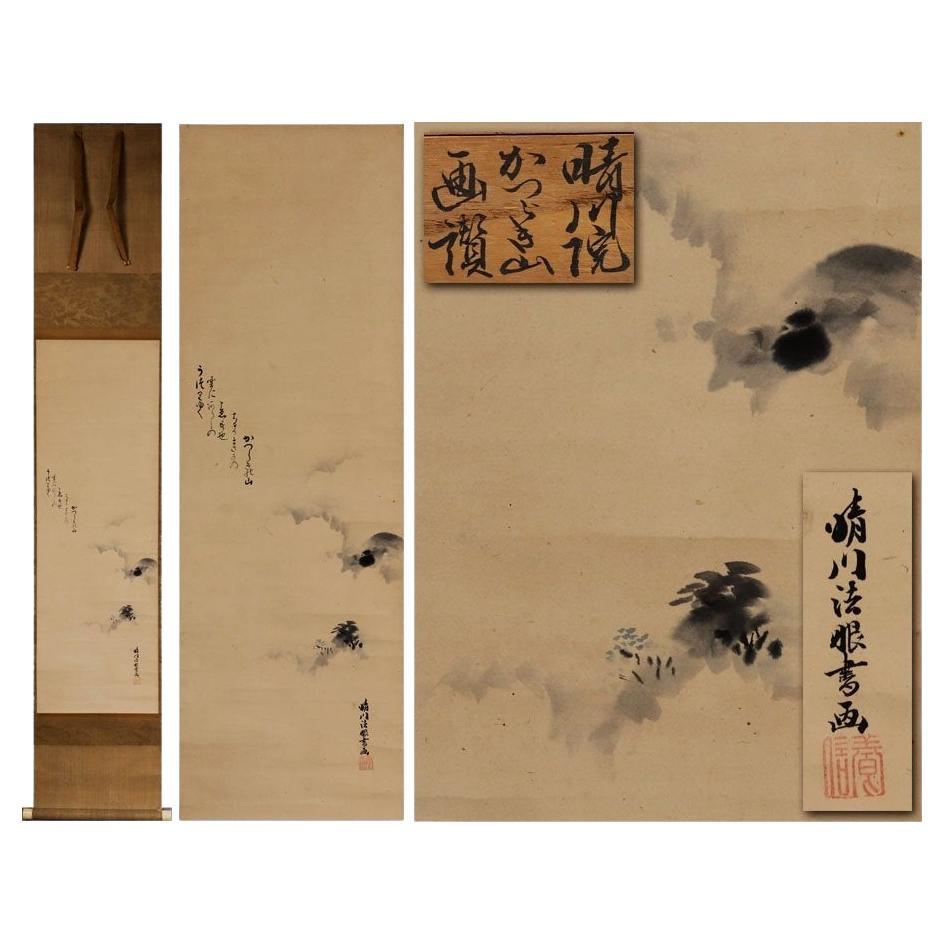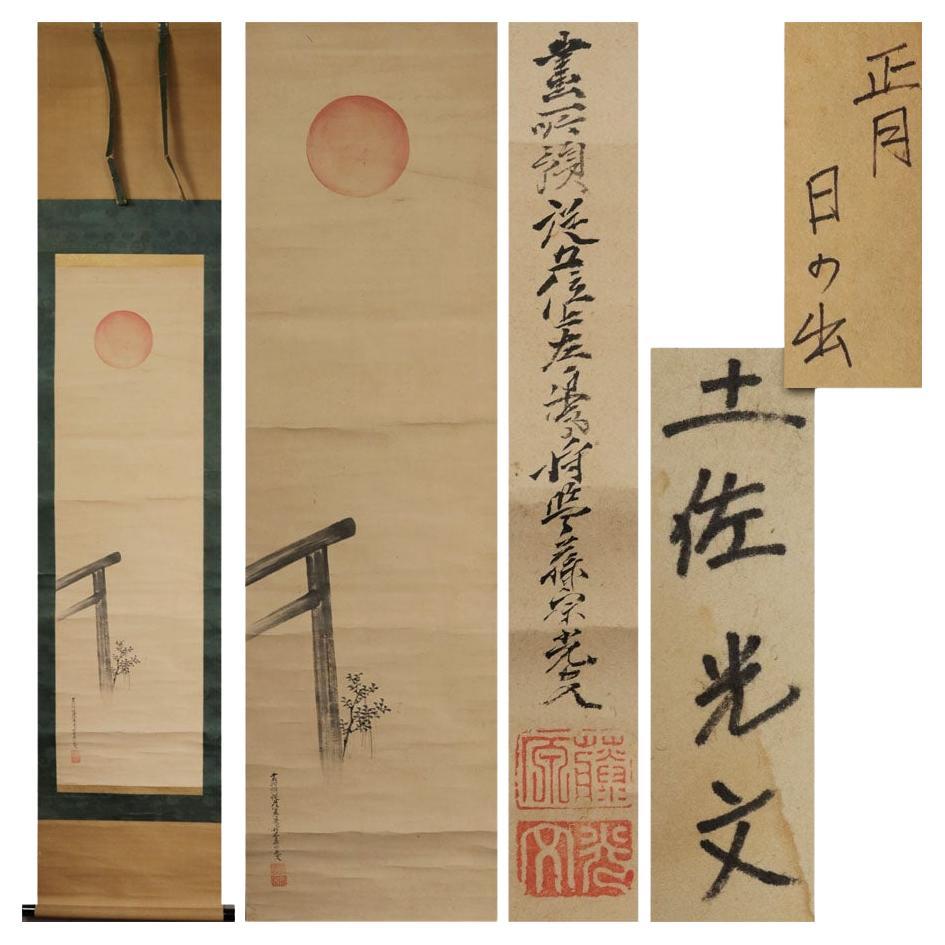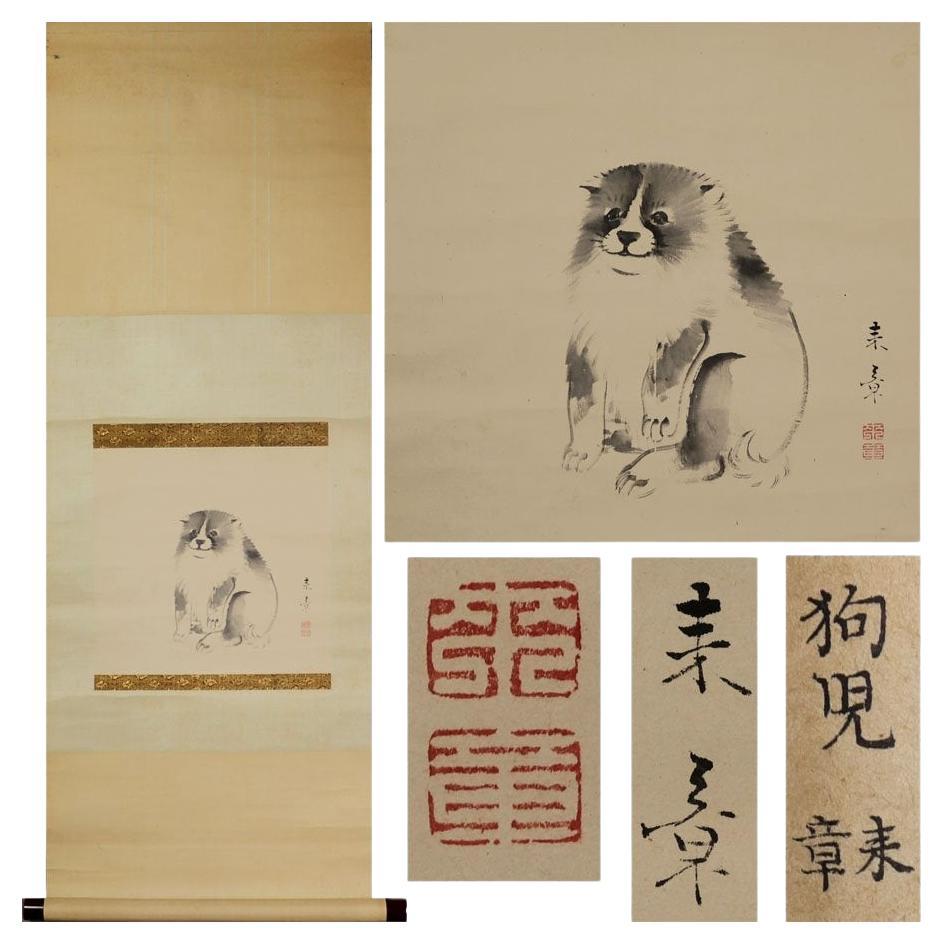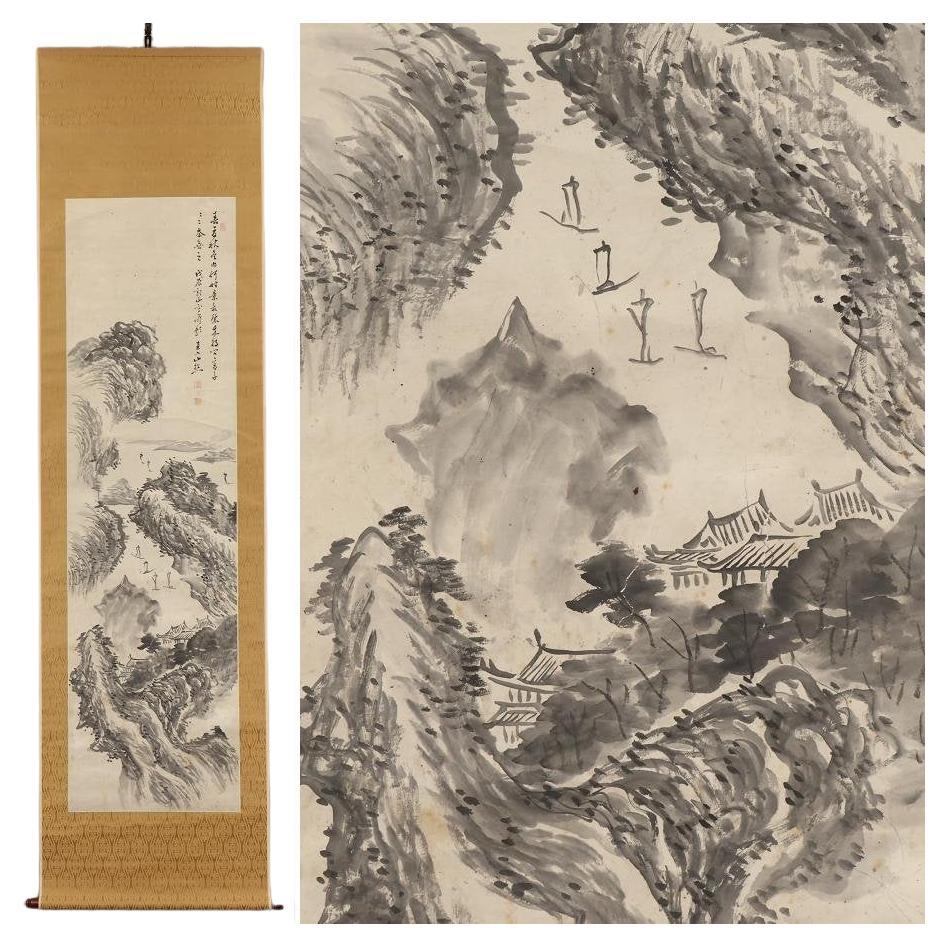Items Similar to Lovely Japanese Nihonga 19th c Edo Scroll by Okamoto Sukehiko , Winter Hermit
Want more images or videos?
Request additional images or videos from the seller
1 of 16
Lovely Japanese Nihonga 19th c Edo Scroll by Okamoto Sukehiko , Winter Hermit
About the Item
[Authentic work] ◆ Akihiko Okamoto ◆ Winter forest landscape ◆ Japanese painting ◆ Hand-painted ◆ Paper ◆ Hanging scroll ◆
Okamoto (Sukehiko Okamoto)
Sukehiko Okamoto
[Art yearbook appraised value 1.2 million yen]
Bunsei 6 (1823) - Meiji 16 1883
Japanese painter from the end of the Edo period to the beginning of the Meiji period.
His first name was Akihiko, his character was Zirou, his name was Gyosuien, his childhood name was Yasukichi, and his common name was Shiba. Born in Owari Province. Teachers: Toyohiko Okamoto and Goharu.
[Brief history and style]
Born in Handa Village, Chita District, Owari Province, as the fourth son of Hanshichi Oguri.
His father, Hanshichi, called Hakukei and was one of the Ten Tetsu under Kureharu, was born in 1792 and passed away on May 17, 1837 (June 19, 1837) at the age of 46.
Akihiko loved painting since childhood and became a student of Toyohiko Okamoto, a painter of the Shijo school. He had a particularly excellent talent for painting, so Toyohiko wanted to adopt him and let him inherit his family.
He specializes in a style that shows light brushstrokes that have a lyrical feel to them while still being sketchy.
He traveled around Hokuetsu, China, and in his later years lived in Mizue Village, Kuboya District, Bicchu Province, the hometown of Toyohiko, his teacher and adoptive father.
He passed away on November 18, 1883, in Kanazawa, Kaga Province. He passed away at the age of 61. He will be buried at Mt. Utatsu in Kanazawa. His posthumous posthumous name was ``Sumijinin Akio Akihiko Koji.''
This work is drawn by hand and on paper.
The box is a combined box.
This paper has small stains, wrinkles, curling wrinkles, and folds.
The front cover has small stains, wrinkles, moth bites on the edges, scuffs, and stains on the back.
Size:
Approximately [height 201cm x width 63cm/(main paper) 126cm x 51cm]
- Dimensions:Height: 79.14 in (201 cm)Width: 24.81 in (63 cm)Depth: 0.04 in (1 mm)
- Style:Edo (Of the Period)
- Materials and Techniques:
- Period:
- Date of Manufacture:ca 1850
- Condition:Wear consistent with age and use.
- Seller Location:Amsterdam, NL
- Reference Number:
About the Seller
5.0
Gold Seller
These expertly vetted sellers are highly rated and consistently exceed customer expectations.
Established in 2015
1stDibs seller since 2019
158 sales on 1stDibs
Typical response time: 8 hours
- ShippingRetrieving quote...Ships From: Amsterdam, Netherlands
- Return PolicyA return for this item may be initiated within 14 days of delivery.
More From This SellerView All
- Lovely Japanese 19th c Edo Scroll Okumura Sekiran Nihonga Painting MountainLocated in Amsterdam, Noord Holland"Early Summer Colored Waterfall" is a work drawn by Sekiran Okumura as you can see. The brilliance of the fresh greenery and the cool, powerful presence of the waterfall are overw...Category
Antique 18th Century Edo Paintings
MaterialsSilk
- Lovely Japanese 18/19th c Edo Scroll Kano Osanobu Nihonga Painting MountainLocated in Amsterdam, Noord HollandKano Osanobu (狩野養信) Osanobu Kano (born August 18, 1796; died June 12, 1846) was the ninth painter of the Kobikicho Kano School in the Edo period. His common name was Shozaburo. His ...Category
Antique 18th Century Edo Paintings
MaterialsSilk
- Lovely Japanese 19th c Edo Scroll Tosa Mitsufumi Nihonga Painting Rising SunLocated in Amsterdam, Noord HollandProduct Description The item below was hand-painted by Mitsufumi Tosa.It depicts a torii gate at the rising sun, making it perfect for New Year's and auspicious occasions. [Tosa...Category
Antique 19th Century Edo Paintings
MaterialsSilk
- Japanese Nihonga Painting 19th c Edo Scroll by Nakajima Raiaki River landscapeLocated in Amsterdam, Noord Holland[Raisho Nakajima] lived from 1796 to 1871, at the end of the Edo period and early Meiji period. A person from Otsu, Omi Province (Shiga Prefecture). His name is Ziqing. His names i...Category
Antique 19th Century Edo Paintings
MaterialsSilk
- Japanese Nihonga Painting 19th c Edo Scroll by Seiki Yokoyama Landscape ShijoLocated in Amsterdam, Noord Holland[Authentic work] ◆ Seiki Yokoyama ◆ Landscape ◆ Rural landscape ◆ Japanese painting ◆ Shijo school ◆ Hand-painted ◆ Paperback ◆ Hanging scroll ◆ Seiki Yokoyama [Art yearbook appra...Category
Antique 19th Century Edo Paintings
MaterialsSilk
- Japanese Nihonga Painting 19th c Edo Scroll by Tonomura Chokunyu River landscapeLocated in Amsterdam, Noord Holland[Authentic work] ◆Tanomura Chokunyu ◆Ink painting landscape ◆Japanese painting ◆Handpainted ◆ Paper ◆ Hanging scroll ◆ Chokunyu Tanomura 1814 (Bunka 11) - 1907 (Meiji 40) [Art yearbook appraised value 8 million yen] "A child prodigy in painting, Tanomura Chokunyu originally modeled himself after the style of the famous Tanomura Chikuden (1777-1835), who had adopted him at the age of eight. After Chikuden's death, Chokunyu took up an intense study of imported Chinese paintings." Paul Berry in: Literati Modern, p.136.) - The certificate box was inscribed by Tajika Chikuson (1864-1922), one of Chokunyu's key disciples. Around 1840, he studied Confucianism under Kotake Shinozaki in Osaka, deepened his friendships with Heihachiro Oshio and Tessai Tomioka through sencha, and began to be recognized as a painter. Furthermore, in 1862, he founded and hosted the Seiwan Tea Ceremony (a sencha tea ceremony), which achieved great fame. In 1868, he moved to Kyoto and participated in the establishment of the Kyoto Prefectural Painting School (opened in 1880), serving as its principal and making efforts to foster the next generation.Furthermore, in 1996, he established the Japan Nanga Association with Tessai and others, and established the Japan Nanga Association, which was established in modern Japan. He made a great contribution to painting and the southern painting...Category
Antique 19th Century Edo Paintings
MaterialsSilk
You May Also Like
- 19th Century Japanese Scroll Painting by Igarashi Chikusa, Poppies & ButterfliesLocated in Kyoto, JPPoppies & Butterflies Ink, pigment and gofun on silk Igarashi Chikusa (1774-1844) Signature: Chikusa Ran Zen Upper Seal: Ran Shuzen Lower Seal: Kyoho Dimensions: Scroll: H. 68” x W. 18” (172cm x 45cm) Image: H. 38.5’’ x W. 12.5’’ (98cm x 32cm) This composition shows elegant images of poppies and the butterflies that are inevitably drawn to them. It captures a momentary glimpse into a world both visually dazzling and startlingly realistic. The painting is infused with sensitivity and attention to seasonal change and weather conditions. The thin and fragile poppies are beautifully depicted with brilliant colors and the butterflies are similarly infused with life. The painting is on silk which requires extremely precise painting skills as no element once painted can be removed. Poppies were a favorite subject of Rinpa school artists through the ages. Originally they were somewhat abstracted but by the age of Sakai Hoitsu...Category
Antique Early 19th Century Japanese Edo Paintings and Screens
MaterialsSilk
- Set of 6 Large Kakemonos Japanese Mythology, 19th Century Japan circa 1800 EdoLocated in Beuzevillette, FRBeautiful set of 6 large kakemonos from 19th century Japanese mythology. Paper support with a canvas pasted on the paper Wonderful set that is part of Japan's history and beliefs When not hung, the Kakemonos are rolled up. circa 1800 - Japan - Edo Period A kakemono translates as "object to hang". In Japan this refers to a painting or calligraphy, most often done on silk or paper framed in a scroll that was intended to be hung on walls or in public lighting. This particular form, which allows them to be in a roll, dates back to the Tang dynasty in China (this would be related to the copying and preservation of ancient Buddhist texts). A Kami is a deity or spirit worshipped in the Shinto religion. A Yokai is a spirit, ghost, demon, or strange apparition from the creatures of Japanese folklore. Each of these kakemonos represents a unique story: - A kami, a Japanese deity, is shown painting a rainbow. Indeed, he performs the action with his right hand while his left hand holds a kind of basket with three pots of paint. This kami has a rather closed attitude. He is standing in a dark and tormented sky. Below this figure, 8 villagers are dressed in traditional Japanese clothes. Their faces are softened. They are not afraid of the elements made by the kami above their heads. - A character with an unreal look is holding a kind of jar with his two hands, which he spills on human figures above. This being is floating in the air, probably a character from mythology, perhaps Susanoo. Underneath, villagers on umbrellas. They are trying to protect themselves as best they can from what is falling on them. One of them is carrying baskets with fish on her shoulders. A character in the background is thrown forward and falls. - On this kakemono, the god Raijin, dressed in a white and blue outfit, strikes the sky with his two drum hammers to create lightning and its thunderous sound. Surrounded by Tomoe and a long red scarf, Raijin, enraged and with dishevelled hair, creates a dark and violent storm. The villagers seem frightened by this meteorological phenomenon. One of the villagers can be seen fainting in the arms of a man. This scene may seem chaotic, but Japanese legend tells us that once a field is struck by lightning, the harvest is good. - On this kakemono, we see an unreal-looking figure holding a fan, as if he were sweeping away the bad weather, or simply producing gusts of wind. He is probably the kami of wind and air, Shina tsu-hiko. The figures below him seem surprised by so much wind. An umbrella flies away on the left, the women hold their hair and scarf, the clothes are caught in the power of the wind, there is even a woman on the ground on the bottom left. - This Kakemono represents a short moment. This Raiju is a yokai (ghost spirit...Category
Antique 19th Century Japanese Edo Paintings
MaterialsPaper
- 19th Century Japanese Edo Six Panel Kano School Landscape ScreenLocated in Rio Vista, CALate Edo period 19th century Japanese six-panel landscape screen featuring a cypress tree over a flowering hibiscus with a pair of hototogisu birds. Kano school painted with ink and ...Category
Antique 19th Century Japanese Edo Paintings and Screens
MaterialsSilk, Wood, Paper
- Japanese Painting, Hanging Scroll, 19th Century Bamboo in MoonlightLocated in Kyoto, JPBamboo in moonlight Gamo Rakan (1784-1866) Hanging scroll, ink on silk. Dimensions: Scroll: 201 cm x 58 cm Image: 137 cm x 45 cm In this early 19th century work by Gamo Rakan a light ink wash applied to the silk background silhouettes the moon and suggests the atmosphere of early evening. Even though it is a literati subject, Rakan’s bamboo is quite realistic with a strong decorative style. The painting finds its inspiration from Chinese Ming dynasty painters who often used a single-tone, jet black stroke to emphasize the calligraphic nature of bamboo. In a different era, decorative would have been seen as somewhat unrefined. But increasingly in the Edo period, it was the hallmark of high style. The Japanese people, in particular the rising merchant class, had gradually become apathetic toward the traditional Sesshu and Kano schools of painting. Chinese professional and amateur painters living in the port of Nagasaki during the 18th century had a profound effect on Japanese painting and the freshness of their style and its decorative appeal contributed greatly to its popularity. Gamo Rakan’s teacher, Tani Buncho...Category
Antique Early 19th Century Japanese Edo Paintings and Screens
MaterialsSilk
- Japanese Hanging Scroll, Late 19th CenturyLocated in New York, NYA Japanese hanging scroll or Kakejiku, circa 1890, depicting bamboo grass and a rabbit. In Japanese culture, the rabbit is a symbol of cleverne...Category
Antique 1890s Japanese Meiji Paintings
MaterialsParchment Paper
- Japanese Six Panel Screen with Hotei, Edo Period, Early 19th CenturyLocated in Austin, TXA delightful Japanese six panel painted paper screen featuring the beloved figure Hotei, Edo Period, early 19th century. Hotei, called Budai in China, and known as the Laughing Buddha or Fat Buddha in the West, is considered to be an emanation of Maitreya, the Buddha of the Future. In Japan, he also holds a special place as one of the Seven Lucky Gods, being the god of fortune, and protector of children. He is always portrayed as a mirthful and corpulent man, dressed in loose robes that show off his round belly. He carries a sack with him, said to be filled with treasure. As the protector of children, he is often portrayed with them playing on or around him, as he is here. The children portrayed in this screen are dressed in Chinese style clothing...Category
Antique Early 19th Century Japanese Edo Paintings and Screens
MaterialsSilk, Paper





